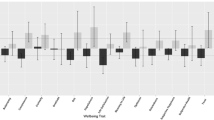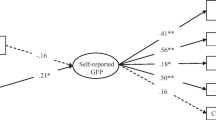Abstract
The occurrence of many life events is not entirely random but genetically influenced. The current study examined the sources underlying the stability or recurrence of life events and the developmental interplay between personality traits and life events. In a longitudinal study of 338 adult twin pairs we estimated (1) the genetic and environmental sources of continuity in aggregates of life events, (2) the sources through which personality influences the experience of life events, and (3) the sources through which life events influence personality. Unlike personality which showed both genetic and environmental influences on substantial continuity over time, stability of life events was moderate and mainly influenced by genetic factors. Significant associations between personality and life events were specific to certain personality traits and qualitative aspects of life events (controllable positive, controllable negative, and less controllable negative), primarily directional from personality to life events, and basically genetically mediated. Controlled for these genetic associations, we also found some small and basically environmentally mediated effects of life events on personality traits. The results support the concept of genotype–environment correlation as a propulsive mechanism of development.





Similar content being viewed by others
Notes
We ran additional multivariate regression analyses with all three life event aggregates at the first measurement occasion as predictors for each score at the second measurement occasion. We found that only the continuity within qualitative aspects were significant when controlling for prior links between qualitative aspects of life events (β = .39 for positive events; β = .48 for controllable negative events; β = .27 for less controllable events). There was one exception: Controllable negative events at the first measurement occasion additionally accounted for a significant amount of variance in less controllable life events at the second measurement occasion (β = .17).
Prior to longitudinal analyses, we estimated within-time MZ and DZ twin correlations. For positive life events, MZ twin correlations were .24 at time 2 and .31 at time 3, whereas DZ correlations were .09 and .19, respectively; for controllable negative life events, MZ and DZ twin correlations were .34 and .12 at time 2 and .35 and .12 at time 3; and for less controllable negative life events, we found MZ and DZ twin correlations of .31 and .15 at time 2 and .42 and .30 at time 3. For all scores and both measurement occasions, an univariate twin model allowing for additive genetic (a 2) and nonshared environmental effects (e 2) provided the best model fit compared to more complex models additionally allowing for shared environmental effects or nonadditive genetic effects and compared to more restrictive models only allowing for nonshared environmental effects. Confidence intervals indicated no significant differences in the amount of genetic variance among LE-scores and across time. Re-running the analyses without opposite-sex DZ pairs led to almost identical results but slightly reduced statistical power.
References
Andrews G (1981) A prospective study of life events and psychological symptoms. Psychol Med 11:795–801
Arbuckle JL (2009) AMOS Users’ Guide 18.0. SPSS, Chicago
Bemmels HR, Burt SA, Legrand LN, Iacono WG, McGue M (2008) The heritability of life events: an adolescent twin and adoption study. Twin Research and Human Genetics 11:257–265
Bentler PM (1990) Comparative fit indices in structural models. Psychol Bull 107:238–246
Billig JP, Hershberger SL, Iacono WG, McGue M (1996) Life events and personality in late adolescence: genetic and environmental relations. Behav Genet 26:543–554
Billings AC, Moos RH (1982) Stressful life events and symptoms: a longitudinal model. Health Psychol 1:99–117
Bleidorn W, Kandler C, Riemann R, Angleitner A, Spinath FM (2009) Patterns and sources of adult personality development: growth curve analyses of the NEO-PI-R scales in a longitudinal twin study. J Pers Soc Psychol 97:142–155
Bleidorn W, Kandler C, Hülsheger UR, Riemann R, Angleitner A, Spinath FM (2010) Nature and nurture of the interplay between personality traits and major life goals. J Pers Soc Psychol 99:366–379
Blonigen DM, Carlson MD, Hicks BH, Krueger RF, Iacono WG (2008) Stability and change in personality traits from late adolescence to early adulthood: a longitudinal twin study. J Pers 76:229–266
Bolinskey PK, Neale MC, Jacobson KC, Prescott CA, Kendler KS (2004) Sources of individual differences in stressful life event exposure in male and female twins. Twin Res 7:33–38
Boomsma DI, Molenaar PCM (1987) The genetic analysis of repeated measures: I. Simplex models. Behav Genet 17:111–123
Cohen J (1988) Statistical power analysis for the behavioral sciences. Lawrence Erlbaum Associates, Hillsdale
Costa PT, McCrae RR (1992) Revised NEO Personality Inventory (NEO-PI-R) and NEO Five-Factor Inventory (NEO-FFI) Professional Manual. Psychological Assessment Resources, Odessa
Costa PT, Herbst JH, McCrae RR, Siegler IC (2000) Personality at midlife: stability, intrinsic maturation, and response to life events. Assessment 7:365–378
Dunn J, Plomin R (1990) Separate lives. Why siblings are so different?. Basic Books, New York
Ge X, Natsuaki MN, Neiderhiser JM, Reiss D (2009) The longitudinal effects of stressful life events on adolescent depression are buffered by parent-child closeness. Development and Psychopathology 21:621–635
Gottlieb G (1991) Experiential canalization of behavioral development: theory. Dev Psychol 27:4–13
Gottlieb G (2003) On making behavioral genetics truly developmental. Human Dev 46:337–355
Headey BW, Wearing AJ (1989) Personality, life events, and subjective well-being: toward a dynamic equilibrium model. J Pers Soc Psychol 57:731–739
Hershberger SL, Lichtenstein P, Knox SS (1994) Genetic and environmental influences on perceptions of organizational climate. J Appl Psychol 79:24–33
Johnson W, McGue M, Krueger RF, Bouchard TJ (2004) Marriage and personality: a genetic analysis. J Pers Soc Psychol 86:285–294
Johnson W, McGue M, Krueger RF (2005) Personality stability in late adulthood: a behavioral genetic analysis. J Pers 73:523–551
Kandler C, Riemann R, Kämpfe N (2009) Genetic and environmental mediation between measures of personality and family environment in twins reared together. Behav Genet 39:24–35
Kandler C, Bleidorn W, Riemann R, Spinath FM, Thiel W, Angleitner A (2010a) Sources of cumulative continuity in personality: a longitudinal multiple-rater twin study. J Pers Soc Psychol 98:995–1008
Kandler C, Riemann R, Spinath FM, Angleitner A (2010b) Sources of variance in personality facets: a multiple-rater twin study of self-peer, peer–peer, and self–self (dis-) agreement. J Pers 78:1565–1594
Kandler C, Bleidorn W, Riemann R, Angleitner A, Spinath FM (in press) The genetic links between the Big Five personality traits and general interest domains. Pers Soc Psychol Bull
Kendler KS (2001) Twin studies of psychiatric illness: an update. Arch Gen Psychiatry 58:1005–1014
Kendler KS, Baker JH (2007) Genetic influences on measures of the environment: a systematic review. Psychol Med 37:615–626
Kendler KS, Neale M, Kessler R, Heath A, Eaves L (1993) A twin study of recent life events and difficulties. Arch Gen Psychiatry 50:789–796
Kendler KS, Gardner CO, Prescott CA (2003) Personality and the experience of environmental adversity. Psychol Med 33:1193–1202
Little RJA (1988) A test of missing completely at random for multivariate data with missing values. J Am Stat Assoc 83:1198–1202
Löckenhoff CE, Terracciano A, Patriciu NS, Eaton WW, Costa PT (2009) Self-reported extremely adverse life events and longitudinal changes in five-factor model personality traits in an urban sample. J Trauma Stress 22:53–59
Magnus K, Diener E, Fujita F, Pavot W (1993) Extraversion and neuroticism as predictors of objective life events: a longitudinal analysis. J Pers Soc Psychol 65:1046–1053
McCrae RR, John OP (1992) An introduction to the five-factor model and its applications. J Pers 60:175–215
Middeldorp CM, Cath DC, Vink JM, Boomsma DI (2005) Twin and genetic effects on life events. Twin Res Human Genetics 8:224–231
Middeldorp CM, Cath DC, Beem AL, Willemsen G, Boomsma DI (2008) Life events, anxious depression and personality: a prospective and genetic study. Psychol Med 38:1557–1565
Neale MC, Maes HHM (2004) Methodology for genetic studies of twins and families. Kluwer Academic Publishers BV, Dordrecht
Ostendorf F, Angleitner A (2004) NEO-Persönlichkeitsinventar, revidierte Form, NEO-PI-R nach Costa und McCrae [Revised NEO Personality Inventory, NEO-PI-R of Costa and McCrae]. Hogrefe, Göttingen
Plomin R, Bergeman CS (1991) The nature of nurture: genetic influences on “environmental” measures. Behav Brain Sci 14:373–386
Plomin R, Daniels D (1987) Why are children from the same family so different from each other. Behav Brain Sci 10:1–16
Plomin R, DeFries JC, Loehlin JC (1977) Genotype–environment interaction and correlation in the analysis of human behavior. Psychol Bull 84:309–322
Plomin R, Lichtenstein P, Pedersen N, McClearn GF, Nesselroade JR (1990) Genetic influences on life events during the last half of the life span. Psychol Aging 5:25–30
Plomin R, Asbury K, Dunn J (2001) Why are children in the same family so different? Nonshared environment a decade later. Can J Psychiatry 46:225–233
Purcell S (2002) Variance components models for gene-environment interaction in twin analysis. Twin Res Human Genet 5:554–571
Saudino KJ, Pederson N, Lichtenstein P, McClearn GE, Plomin R (1997) Can personality explain genetic influences on life events? J Pers Soc Psychol 72:196–206
Scarr S (1993) Biological and cultural diversity: the legacy of Darwin for development. Child Dev 64:1333–1353
Scarr S, McCartney K (1983) How people make their own environments: a theory of genotype→environment effects. Child Dev 54:424–435
Schmidt FL, Hunter JE (1998) The validity and utility of selection methods in personnel psychology: practical and theoretical implications of 85 years of research findings. Psychol Bull 124:262–274
South SC, Krueger RF (2008) An interactionist perspective on genetic and environmental contributions to personality. Soc Personal Psychol Compass 2:929–948
Spinath FM, Wolf H, Angleitner A, Borkenau P, Riemann R (2005) Multimodale Untersuchung von Persönlichkeiten und kognitiven Fähigkeiten. Ergebnisse der deutschen Zwillingsstudien BILSAT und GOSAT [Multimodal investigation of personality and cognitive ability: Results from two German twin studies BiLSAT and GOSAT]. Zeitschrift für Soziologie der Erziehung 25:146–161
Steyer R, Schmitt M, Eid M (1999) Latent state-trait theory and research in personality and individual differences. Eur J Personal 13:389–408
Turkheimer E, Waldron M (2000) Nonshared environment: a theoretical, methodological, and quantitative review. Psychol Bull 126:78–108
Vaidya JG, Gray EK, Haig J, Watson D (2002) On the temporal stability of personality: evidence for differential stability and the role of life experiences. J Personal Soc Psychol 83:1469–1484
Viken RJ, Rose RJ, Kaprio J, Koskenvuo M (1994) A developmental genetic analysis of adult personality: extraversion and neuroticism from 18 to 59 years of age. J Personal Soc Psychol 66:722–730
Visscher PM, Hill WG, Wray NR (2008) Heritability in the genomics era—concepts and misconceptions. Nat Rev Genet 9:255–266
Weiner B (1986) An attributional theory of motivation and emotion. Springer, Heidelberg
Author information
Authors and Affiliations
Corresponding author
Additional information
Edited by Deborah Finkel.
Rights and permissions
About this article
Cite this article
Kandler, C., Bleidorn, W., Riemann, R. et al. Life Events as Environmental States and Genetic Traits and the Role of Personality: A Longitudinal Twin Study. Behav Genet 42, 57–72 (2012). https://doi.org/10.1007/s10519-011-9491-0
Received:
Accepted:
Published:
Issue Date:
DOI: https://doi.org/10.1007/s10519-011-9491-0




